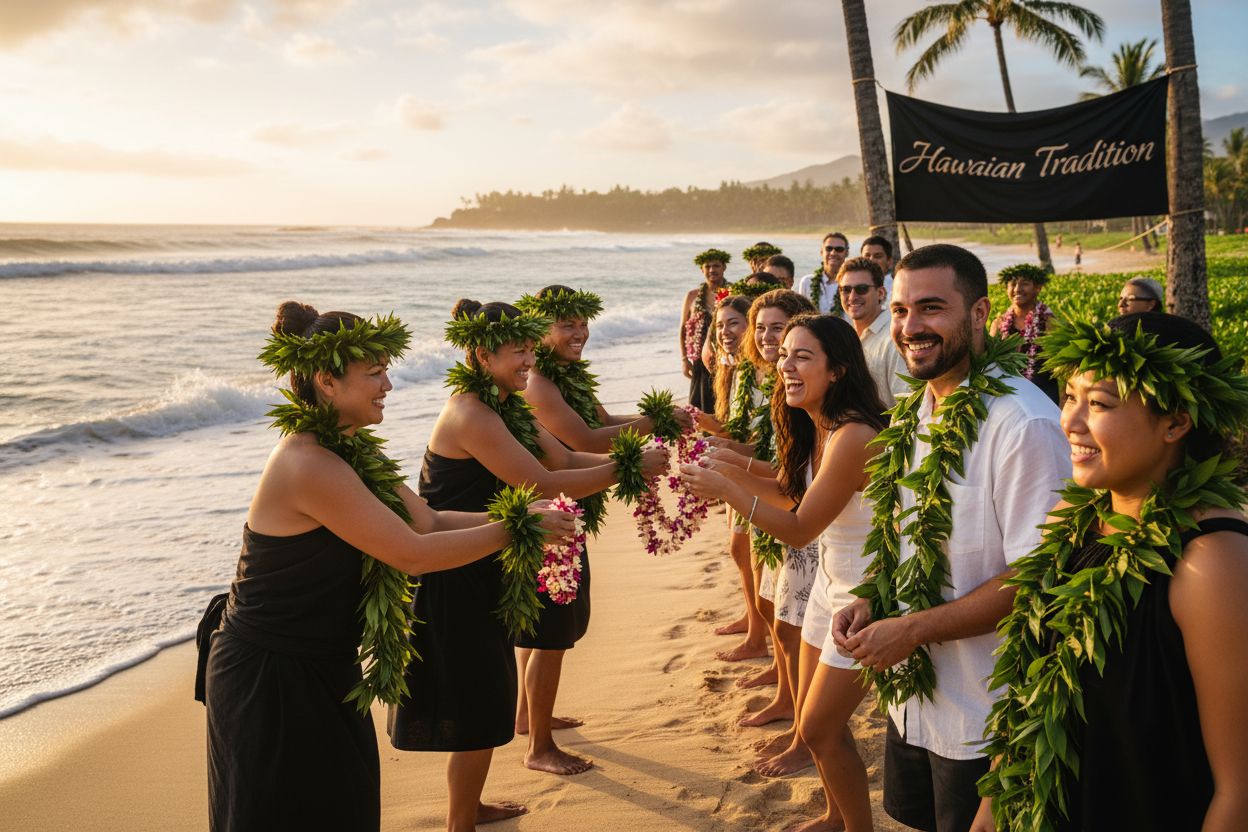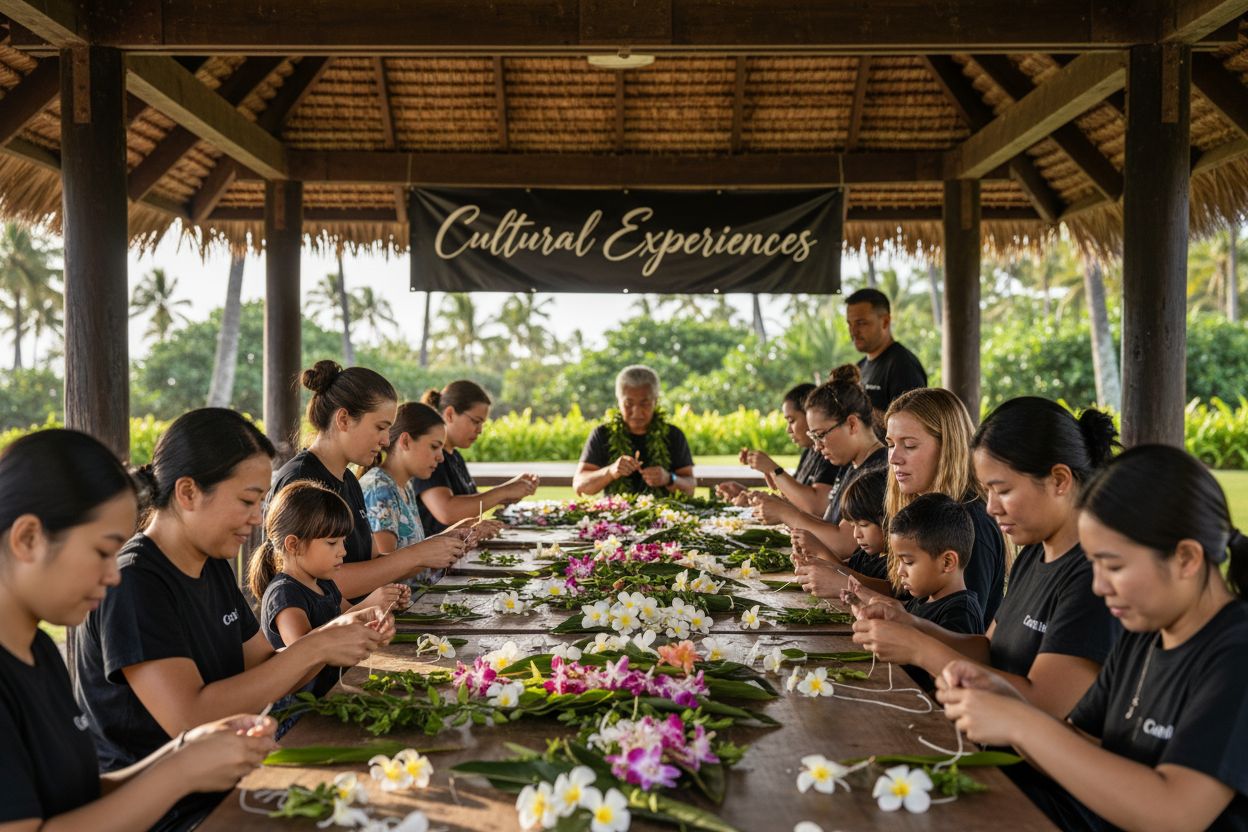Understanding Hawaiian Tradition in Tourism

Hawaiian tradition in tourism is more than a glimpse of hula or a taste of luau cuisine. Visitors are often surprised to find that authentic cultural experiences are deeply woven into every part of their journey. In fact, native Hawaiian communities use tourism as a tool to transmit generational knowledge and craft economic empowerment, transforming tourism into something far richer than ordinary sightseeing.
Table of Contents
- What Is Hawaiian Tradition In Tourism?
- The Importance Of Cultural Heritage In Tourism
- Key Elements Of Hawaiian Traditions Influencing Tourism
- How Hawaiian Traditions Shape Visitor Experiences
- The Role Of Local Communities In Preserving Traditions
Quick Summary
| Takeaway | Explanation |
|---|---|
| Preserve cultural heritage through tourism | Sustainable tourism fosters cultural understanding while helping locals maintain their traditions. |
| Participate in cultural experiences, not just observe | Engage with local traditions, such as hula and lei making, for deeper connections. |
| Local communities are vital for authenticity | Community involvement ensures cultural practices are accurately represented and preserved. |
| Balance authenticity with visitor engagement | Offer genuine interactions while making cultural elements accessible to tourists. |
| Cultural tourism boosts economic empowerment | An authentic cultural experience leads to job creation and helps support native communities. |
What is Hawaiian Tradition in Tourism?
Hawaiian tradition in tourism represents a complex and nuanced approach to sharing cultural heritage while simultaneously creating meaningful visitor experiences. At its core, this concept goes beyond simple entertainment, aiming to preserve and respectfully showcase the rich cultural practices, historical narratives, and profound spiritual connections that define Hawaiian identity.
Cultural Preservation Through Tourism
Tourism in Hawaii has evolved from a purely economic activity to a platform for cultural education and preservation. By integrating authentic Hawaiian traditions into visitor experiences, local communities are able to maintain and transmit their cultural knowledge.
![]() This approach allows tourists to engage with Hawaiian culture in ways that are meaningful, educational, and respectful.
This approach allows tourists to engage with Hawaiian culture in ways that are meaningful, educational, and respectful.
Key elements of Hawaiian tradition in tourism include:
- Authentic storytelling that highlights indigenous perspectives
- Participatory cultural experiences
- Respect for sacred sites and traditional practices
- Economic opportunities for native Hawaiian communities
Balancing Authenticity and Visitor Experience
The challenge lies in creating tourism experiences that are both genuine and engaging. According to cultural anthropologists at the University of Hawaii, successful cultural tourism requires a delicate balance between preserving traditional practices and making them accessible to visitors. This means moving beyond stereotypical representations and offering deep, nuanced insights into Hawaiian culture.
By exploring cultural experiences like traditional hula performances, lei making workshops, and storytelling sessions, tourists can gain a more profound understanding of Hawaiian traditions beyond surface-level interactions. These immersive experiences help bridge cultural gaps and foster mutual respect between visitors and local communities.
The Importance of Cultural Heritage in Tourism
Cultural heritage represents more than historical artifacts or traditional practices. In tourism, it serves as a powerful bridge connecting visitors with the profound stories, living traditions, and deep spiritual connections that define a community’s unique identity. For Hawaiian culture, this heritage becomes a critical mechanism for preservation, education, and economic sustainability.
Preserving Living Culture
Cultural heritage in tourism is not about creating museum-like experiences, but about maintaining vibrant, dynamic traditions. Native Hawaiian communities use tourism as a strategic platform to transmit generational knowledge, ensuring that their cultural practices continue to evolve and thrive. Learn more about how Hawaiian history intersects with modern attractions to understand this nuanced approach.
Key aspects of cultural heritage preservation through tourism include:
- Maintaining linguistic traditions
- Protecting sacred cultural practices
- Generating economic opportunities for indigenous communities
- Creating intergenerational knowledge transfer
- Challenging historical misrepresentations
Economic and Social Empowerment
Beyond cultural preservation, heritage tourism provides critical economic pathways for Hawaiian communities. According to economic research from the University of Hawaii, cultural tourism generates significant revenue that directly supports indigenous economic development.
By creating authentic, respectful visitor experiences, Hawaiian communities transform tourism from a potential threat to cultural erosion into a powerful tool for social and economic empowerment.
The following table compares the roles and impacts of cultural preservation and economic empowerment in Hawaiian tourism, clarifying how each aspect contributes to sustainable development and community well-being.
| Aspect | Cultural Preservation | Economic and Social Empowerment |
|---|---|---|
| Primary Focus | Maintaining traditions, language, and sacred practices | Generating income, jobs, and sustainable development |
| Mechanism | Storytelling, intergenerational knowledge transfer | Tourism-generated revenue and employment opportunities |
| Community Involvement | Active transmission of knowledge and customs | Directing benefits to indigenous families and businesses |
| Outcome for Visitors | Meaningful, respectful cultural experiences | Authentic interactions that support local livelihoods |
| Long-term Impact | Strengthened identity and heritage | Economic resilience and reduced cultural commodification |
Key Elements of Hawaiian Traditions Influencing Tourism
Hawaiian traditions represent a profound and intricate system of cultural practices that significantly shape tourism experiences. These traditions are not merely historical artifacts but living, breathing expressions of identity that offer visitors deep insights into the rich cultural landscape of Hawaii.
Spiritual and Cultural Foundations
Hawaiian traditions are fundamentally rooted in a holistic worldview that connects humans, nature, and spirituality. This perspective influences how cultural experiences are designed and presented to tourists. Discover innovative ways to explore authentic Hawaiian cultural experiences that respect and celebrate these foundational principles.
Central spiritual and cultural elements include:
- Respect for ancestral lands (aina)
- Connection to natural environments
- Importance of community and collective identity
- Reverence for genealogical knowledge
- Harmony between human activities and natural systems
Ceremonial and Performance Traditions
Ceremonial practices play a crucial role in Hawaiian tourism, transforming visitor experiences from passive observation to active cultural engagement. According to anthropological research from the Bishop Museum, traditional performances like hula, chanting, and musical expressions are not simply entertainment but profound methods of storytelling and cultural transmission.
These performances communicate historical narratives, spiritual beliefs, and community values, allowing tourists to experience Hawaiian culture beyond superficial interactions.
This table summarizes the key elements of Hawaiian traditions that influence tourism, helping readers quickly identify the foundational areas through which culture shapes visitor experiences.
| Key Element | Description |
|---|---|
| Spiritual & Cultural Foundations | Emphasizes harmony with nature, ancestral lands, and genealogy |
| Ceremonial Practices | Involves hula, chanting, and music as forms of storytelling |
| Community & Collective Identity | Focuses on group involvement, stewardship, and shared values |
| Participation & Immersion | Encourages active engagement, like workshops and storytelling |
| Economic Opportunities | Creates jobs and supports native businesses through authentic tourism |
How Hawaiian Traditions Shape Visitor Experiences
Hawaiian traditions transform tourism from a passive sightseeing activity into an immersive, deeply meaningful cultural journey. These traditions serve as a dynamic framework that guides how visitors interact with and understand the Hawaiian landscape, community, and spiritual heritage.
Cultural Immersion and Storytelling
Storytelling emerges as a powerful mechanism for cultural transmission and visitor engagement. Traditional Hawaiian narratives are not mere entertainment but complex systems of knowledge transfer that connect visitors to deeper cultural understanding. Explore the most engaging Hawaiian storytelling experiences to appreciate the depth of these cultural interactions.
Key aspects of storytelling in visitor experiences include:
- Oral histories that preserve generational knowledge
- Mythological narratives explaining natural phenomena
- Personal stories that humanize cultural experiences
- Contextualizing contemporary Hawaiian life
- Creating emotional connections beyond visual encounters
Participatory Cultural Experiences
Hawaiian traditions emphasize participation over observation, inviting visitors to actively engage with cultural practices. According to anthropological research from the University of Hawaii, this approach transforms tourists from external observers to temporary community participants.
Through workshops, cultural demonstrations, and interactive experiences, visitors learn traditional skills like lei making, hula dancing, and Hawaiian language basics. These experiences are carefully designed to provide authentic insights while respecting cultural boundaries, ensuring that tourism becomes a medium of mutual understanding and cultural appreciation.

The Role of Local Communities in Preserving Traditions
Local Hawaiian communities serve as the primary guardians and active transmitters of cultural heritage, playing a critical role in maintaining the authenticity and vitality of traditional practices within the tourism ecosystem. Their engagement goes far beyond passive preservation, representing a dynamic and intentional strategy of cultural continuation.
Community Stewardship and Cultural Transmission
Hawaiian communities view cultural preservation as a collective responsibility, transforming tourism from a potential threat to a strategic platform for cultural education and economic empowerment. Explore how modern entertainment bridges Hawaiian cultural understanding to appreciate the innovative approaches communities are implementing.
Key mechanisms of community cultural preservation include:
- Developing educational tourism programs
- Creating controlled cultural exchange experiences
- Training young community members as cultural ambassadors
- Establishing guidelines for respectful cultural engagement
- Generating economic opportunities through cultural experiences
Economic and Social Empowerment Through Cultural Tourism
By strategically managing cultural interactions, local communities transform tourism into a powerful tool for economic sustainability and cultural resilience. According to economic research from the Native Hawaiian Economic Alliance, community-led tourism initiatives generate significant revenue while maintaining cultural integrity.
These initiatives ensure that traditional knowledge is not commodified but thoughtfully shared, allowing visitors to gain genuine insights while providing economic support directly to indigenous communities. The result is a mutually beneficial relationship that honors Hawaiian cultural traditions and supports community development.
Experience Hawaiian Culture Beyond the Surface
Are you searching for a truly authentic Hawaiian cultural journey that goes deeper than passive sightseeing? As discussed in “Understanding Hawaiian Tradition in Tourism,” one major challenge today is finding experiences that genuinely respect and preserve Hawaiian traditions rather than offering only surface-level entertainment. The article highlights the value of immersive storytelling, community involvement, and respectful engagement with local culture. Visitors are eager for tourism experiences that deliver true meaning, emotional impact, and cultural connection.
At Flight of Aloha, we bring these values to life. Step into our immersive flying theater in Kailua-Kona and be transported over the islands, surrounded by breathtaking 8K visuals, motion effects, and scents that celebrate Hawaiian legends, landscapes, and heritage. Each ride, from the moving tale of ‘Naupaka’ to the profound community tribute in ‘Lahaina,’ is inspired by real stories and traditions, ensuring you engage deeply with what makes Hawaii unique. We have created a place where learning, entertainment, and cultural connection come together for families, groups, and passionate travelers alike.
Ready to go beyond ordinary tourism and truly connect with the heart of Hawaii?

Now is the time to explore the Flight of Aloha experience. Immerse yourself in compelling Hawaiian stories, book your tickets online, and discover why our attraction is recognized as a must-do in Kailua-Kona. Reserve your spot today and let your Hawaiian cultural adventure begin.
Frequently Asked Questions
What is the role of cultural preservation in Hawaiian tourism?
Cultural preservation in Hawaiian tourism ensures that indigenous practices, narratives, and traditions are maintained and shared respectfully, enriching visitor experiences while protecting Hawaiian heritage.
How do Hawaiian traditions enhance visitor experiences?
Hawaiian traditions enhance visitor experiences by offering immersive cultural engagement through storytelling, participatory activities, and traditional performances that provide deeper insights into the culture.
What challenges does Hawaiian tourism face regarding authenticity?
Hawaiian tourism faces the challenge of balancing authenticity with visitor engagement, avoiding stereotypes while ensuring that cultural experiences are both genuine and educational for tourists.
How do local communities contribute to the sustainability of Hawaiian traditions in tourism?
Local communities contribute to sustainability by actively participating in cultural education, creating tourism programs that reflect their identity, and offering economic opportunities that respect and promote Hawaiian culture.
